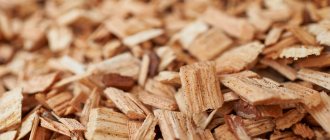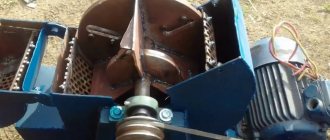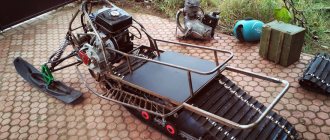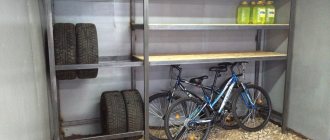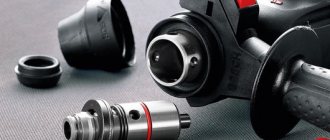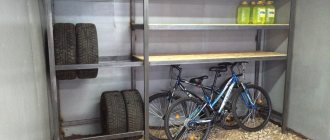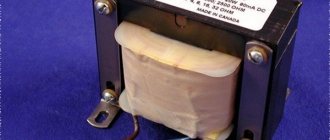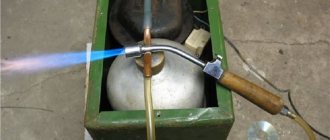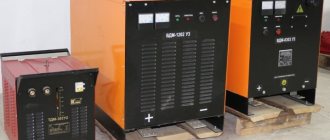A wood concrete chip cutter is a useful device for those who want to make a high-quality mixture for pouring monolithic wood concrete or creating blocks with their own hands. Wood concrete is a modern and popular material, which is created on the basis of cement binder, wood chips and special chemicals. Arbolite has excellent thermal/sound insulation characteristics, large dimensions and light weight, and is widely used in various fields of construction.
To create wood concrete at home, you will need wood chips, which you can make yourself using special equipment. In this way, it will be possible to achieve thorough grinding of chips and uniform size of raw materials, which will significantly increase the strength of the blocks and the quality characteristics of the material. You can make a wood chip cutter with your own hands using ready-made drawings by assembling several main components.
Such a device will be useful even for those who plan to use it only once during the construction of a certain object made of wood concrete. Self-chopping wood chips and preparing a solution for wood concrete will allow you to save a lot. Then the equipment can be used in the form of a garden shredder, which successfully processes waste after autumn garden cleaning, pruning trees and shrubs.
To reduce the cost of the device, you should take the choice of components, parts, and parts seriously. Much can be found at scrap collection points, taken out of old equipment, at enterprises where equipment has recently been modernized (and old components remain unnecessary).
How and where you can find parts to create a wood chip cutter:
- Frame
A rotary hammer machine is made from a channel or a steel angle (the metal may not be new, but without rust).
- Machine body (protective casing), receiving casing
– from a sheet of metal 0.8-2.5 millimeters thick (can be cut from an old car, various floorings, fences).
- Electric motor
– remove from any electrical equipment, old machines (if necessary, replace bearings).
- Pulleys
, equipment for starting/operating the motor.
- Rotor
– use sheet steel or a flywheel from a car engine of suitable diameter (here you will have to insert and weld the hammer chopper shaft into it).
- Knives
- they make a car from springs, giving shape and hardening.
If you have an unnecessary walk-behind tractor on your farm, you can use it to give the wood chipper mobility. If there is a power take-off shaft on the motor, you can connect a wood chipper without disassembling the walk-behind tractor. It is not recommended to use a chainsaw motor, since it can only be connected to the chopper shaft through a chain drive, which requires finding a suitable chain and sprocket on the shaft.
Electric motors from a circular saw, electric planer, or grinder are also not suitable for the equipment (they are more suitable for a small branch chopper, which differs from a wood chipper in scale and performance).
Chip cutter for making wood concrete: operating principle
Before you start making wood concrete chippers with your own hands, you should carefully study the drawings, examine the design, find all the necessary parts and only then assemble them together. The main components of the machine are a chipping disc with knives, as well as a rotor with blades and hammers. The disk is fixed on the working shaft, which is driven by a pulley connected to the engine by a belt. The shaft moves on two roller bearings, the engine is mounted on a frame.
Raw materials are fed manually - the ones to be processed are thrown into the receiving hopper, and then the waste is pulled under hammers/knives. At the last stage of processing, the chips are sent with blades to a sieve and exit the chip cutter through a special opening for unloading. At the entrance, the receiving hopper is made in a funnel format to make feeding raw materials simple and safe.
What characteristics should a wood chipper meet:
- Motor power is about 7.5 kW.
- The motor rotation speed on the working shaft is a maximum of 3000 rpm.
- The optimal rotation speed of the shaft where the disk with knives is mounted is 1500 rpm.
If you increase the shaft rotation speed, there is a possibility that the wood raw material will begin to turn into dust (instead of producing chips of the required size), but the productivity of the equipment increases.
Main units of wood chip cutter, drawing
A homemade rotary hammer crusher can be made independently according to the drawings. The dimensions of the parts do not always have to correspond exactly to those indicated, since the material may be different. The crusher has 220-380 V power supply and includes several main parts.
Chip cutter units for wood concrete:
- Metal body with folding/removable casing.
- Bits with hammers that rotate absolutely freely and are responsible for creating chips. Sectorally should be separated by fenders.
- Knives mounted on a disk.
- Calibrating sieve with holes measuring 15-20 millimeters.
- Bunker where wood raw materials are supplied.
You can find many working drawings online, where there are differences in certain components and dimensions, but the operating principle of the device itself is the same. The equipment is supplied with a voltage of 220 V, the engine transmits rotation through a V-belt transmission to a drum with knives through a shaft and pulley. Wood raw materials are sent to the feed hopper, which is turned into chips up to 25 mm long and up to 5 mm wide (the optimal size for wood concrete).
Equipment price: what does it depend on?
The cost of equipment for the production of wood concrete blocks depends on the manufacturing plant, the region of sale, as well as on the materials used in the machines. Several examples of prices in Russia for equipment :
- mixer – 159,000 rubles;
- brick press – from 46,000 to 59,000 rubles;
- drying equipment – 750,000 rubles;
- forms - from 1800 to 2400 rubles;
- wood chippers – 99,900 rubles.
The cost of equipment also depends on the modification . For example, a brick press with 1 die will be cheaper than equipment with 2-3 dies. A mold for wood concrete with 2 cells will cost less than one with 3-4 cells.
We make a wood concrete chip cutter with our own hands
To make a wood concrete wood chip cutter, you need to prepare all the necessary parts, after which you can begin assembling the unit. Some parts are worth looking for, others are quite possible to do yourself.
Disc with knives
The diameter of the disc should be up to 30-35 centimeters, thickness – 2 centimeters. To eliminate the possibility of jamming of hard/large pieces of raw material, the disk must operate on the flywheel principle, which is why it is made heavy.
You can take a metal blank or cut it out of a piece of sheet steel, then saw through one central hole in the part (to seat the shaft, taking into account the keyed fastening), and also make several mounting holes, 3 grooves, through which the cut pieces of wood will be sent under rotating hammers.
To make knives, take car springs, make 2 holes in each of the knives, then countersink them (you need to recess the screw heads as much as possible), attach them to the disk using bolts with a special countersunk head for a hexagon, due to which it is possible to create a reliable and tight connection . In addition, in this case the bolts will not be able to rotate when the nuts are compressed on the other side.
Hammers
This part is a flat plate up to 5 millimeters thick, located in the rotor. Hammers are responsible for additional grinding of raw materials; it is better to buy them ready-made. The distance between the hammers themselves directly in the crusher should be 24 millimeters.
Sieve for wood chips
To make a sieve, inside which the grinding chamber will be located, take a metal cylinder with a diameter of 30-35 centimeters, made from a sheet of metal 94.2-100 centimeters long.
In the cylinder itself, cells are made with a cross-section of 8-12 millimeters, preferably using a core or a punch (do not drill), so that the edges of the cells are torn or sharp.
Protective cover, funnel, hopper and frame
To create a protective casing and receiving funnel for the receiving hopper, sheet iron 8-12 millimeters thick can be used. The sheets are cut to size and welded according to the drawing. The parts are cut according to previously known sizes and “patterns” (they can be prepared in advance using thick cardboard). Stiffening ribs are made from pipes, channels or angles.
The cutting unit itself should not even minimally cling to the walls of the unit body; it is desirable to place it freely in the body, so the optimal diameter of the flywheel is made smaller in size by about 3-5 centimeters than the size of the body.
The main parts of the crushing unit: these are shaft journals on which support bearings, hammers and a cutting disc are mounted. To form the working shaft, it is enough to cut holes, inlet/outlet sockets intended for supplying raw materials and exiting chips.
The hopper for receiving raw materials is welded at an angle to the body. Electric or mechanical drives are mounted at the final stage: an electric motor is attached to the frame, then pulleys of the required size, and all components are connected by a belt drive. Usually, ordinary car belts of the appropriate diameter are used for this purpose.
Engine
The amount of operating costs and the productivity of the wood chipper will depend on the type of engine. An electric motor is considered the most environmentally friendly option; it is lighter than an internal combustion engine, produces less noise, but also exhibits lower power. It is worth remembering that an electric chip cutter will depend on surges in the voltage level in the network.
A device with a more powerful gasoline engine will work longer, be more productive, and does not require a network or outlet. But the internal combustion engine makes a lot of noise, significantly pollutes the air, and requires constant maintenance and regular refueling.
Provided that the assembled wood concrete wood chip cutter is designed accurately and there is no deviation in coaxiality, you can use a coaxial circuit instead of a belt connection, mounting the shaft connection through a coupling.
Self-created
To set up a production line for wood concrete blocks, it is not necessary to purchase expensive equipment, but in some cases it cannot be replaced. You can make an alternative with your own hands in the case of a chip cutter, mixer and compactor.
How to make a wood chipper yourself?
To make a wood chip cutter with your own hands, you will need a metal sheet up to 20 mm thick . A circle with a diameter of 300-350 mm is cut out of it. A hole is made inside and a key is inserted. Symmetrical slits are made on the outer perimeter of the circle. For knives I use springs from a car, they are cut into strips of metal, and then sharpened and screwed to the base.
It is also necessary to make a hammer mechanism. For this purpose, metal strips with a thickness of 5 mm are used. They are located on the rotor. A sieve is also prepared: it is made from a round metal container, where a ring is cut off, and then holes are made with a drill. In order to conveniently push chips out of the machine, it is necessary to make crossbars on the back of the disk. As the disc rotates, they will also rotate, thereby pushing the chips out.
Mixer
You can build a concrete mixer for wood concrete with your own hands, thereby not having to spend money on equipment from the factory. To do this you will need a 200 liter barrel, wheels, angles, channels and pipes . You also need fittings, a gearbox, and an electrical wire - it is better to make an electric concrete mixer than a mechanical one.
If you take an old-style washing machine, you can use the electric motor from it. You also need bearings and a large amount of fasteners: screws, bolts and nuts.
Note ! You need to prepare tools: a hacksaw, welding machine, grinder, drill, pliers and a set of keys.
First, a welded frame is made, then containers for mixing the solution are assembled. Next, install the electric drive and gearbox, and connect the wiring to them. At the final stage, it is necessary to check all equipment for its serviceability and safety.
Sealant
The seal design consists of several elements:
- table top;
- vibration device;
- table;
- compaction device.
First, the table is made: it consists of legs that are welded to the frame. The frame is made rectangular, its dimensions are 50x70 cm. The length of the legs is adjusted to suit your preferences. The tabletop must have cross braces, as it will be subject to serious loads. It must match the frame format.
The compactor requires a powerful motor; it is recommended to take a product of type VI99/E - it can adjust the oscillation frequency.
Assembling the chip cutter units
The wood concrete chip cutter is assembled in a certain sequence, which must be followed to ensure adequate operation of the equipment.
How and in what order to assemble the main units of the wood chipper:
- First, they start with the chipping block: they put the bearings on the shaft, then the disk and knives, hammers.
- Now you need to prepare the housing for installation: make holes for the shaft/hopper for receiving raw materials and unloading wood chips.
- Next, holes are drilled for the assembly bolts, and the receiving hopper funnel is welded at an angle to the body.
- The drive assembly is carried out as follows: the engine is mounted on the frame, the pulleys are mounted, and the belt is put on.
- Now you need to attach the chipping block to the frame and cover it with a protective casing to eliminate the risk of accidents.
- You can do a dry test run.
Methods for forming arbolite blocks
We have already written about the composition and proportions of the mixture for the production of wood concrete blocks in the first part of this article. Today we will talk about how to properly form and compact the wood concrete mixture, as well as the rules for storing finished blocks.
Currently, there are several ways to form an arbolite mixture:
- Manual compaction on the floor of a production room.
- Manual compaction using a vibrating machine.
- Mechanized compaction using vibrocompression method.
- Forming on a vibrating machine with a weight.
Which one is more preferable depends on the planned production volume.
Let's consider the listed methods in more detail.
Manual compaction on the floor
The presented method is considered the most economical. As a rule, it is used when it is necessary to produce material for building your own house, but sometimes this method is used when opening a new production.
a991enUser FORUMHOUSE
If you don’t have a lot of money, I would start with manual tamping (without a machine at all), that is: a hand tamper plus a vibrating platform or just a hand tamper. With a volume of 100-120 m³ per month, this is an excellent option.
The presented method assumes the following equipment:
- a forced-type mixer or a container for manually mixing the mixture (some use conventional concrete mixers, but their use in practice is not always effective);
- steel forms for blocks;
- manual rammer (steel);
- a flat base on which the forms will be installed (the base is covered with plastic film);
- pallets for storing finished products.
Immediately after mixing, the wood concrete mixture is laid out in molds. Molding is carried out in 2-3 stages: the mixture is placed into molds in layers, and each layer must be compacted sequentially. Before compacting, the mixture should be pierced using a narrow fork.
Whatever molding method you choose, special attention must be paid to the design of the molds themselves. Thus, the size of the form in length and width corresponds to the size of the blocks. The height of the form is always greater than the specified size. This is done so that the required volume of uncompacted mixture can fit into the mold. The compaction coefficient varies within the following limits: from 1.2 to 1.6. Moreover, it will correspond to the average density of structural wood concrete (700 kg/m³). In other words, if your block height is 37 cm, then the minimum height of the form should be 44.5 cm. The form is filled to the top edge, and then the mixture is compacted to the height of the block (the higher the form, the higher the density of the finished blocks and, accordingly, , their strength is higher).
The blocks can be immediately made universal so that their dimensions can simultaneously be suitable for the construction of walls (37 cm thick) and for the construction of partitions (16 cm thick).
ecodrevFORUMHOUSE user
Size –50x37x16. Thanks to all the forum members, this is exactly the size we are making. This block will be universal - wall and partition.
The thickness of the arbolite wall, protected from moisture (insulated), should be 30 cm. If there is no protection - 37 cm.
Molds for wood concrete should be made either of steel (stainless steel) or wood (with stainless steel lining). The body of the mold should consist of two parts, and such a design will have no bottom.
Both halves are connected using metal pins.
Instead of a bottom, a plywood board or a flat base of a concrete floor is used. The surface of the base should be covered with plastic film. This is done in order to protect the base from sticking of the mixture. In this case, linoleum or special solutions can be used to protect the side and bottom surfaces of the mold from adhesion of wood concrete. And here is the protection option used by one of our portal users.
ChombaFORUMHOUSE user
For a long time they played tricks with various “chemistry” intended for lubricating metal forms. As a result, we took used vegetable oil from the food industry (our price is 650 rubles for 50 liters) and tried it. This is the second year we've been using it exclusively. Works great.
It is advisable to equip the walls of wood concrete forms with special fasteners (latches).
Activated during compaction of the mixture, they fix the tamping cover in a position corresponding to the height of the block.
The lid is hammered in using a steel tamper, which was used to sequentially compact several layers of wood concrete mixture.
The manual molding method uses several molds. Each of them is designed for 1 or 2 blocks. This method allows for the demoulding of finished products both instantly (immediately after molding) and after a certain time (10-12 hours after molding). The second option allows you to obtain more durable products.
It is advisable to transfer blocks to pallets 2-3 days after formwork. It is possible to stack blocks on top of each other only 3-4 days after their manufacture, and to store products in three rows (in height) only 6-7 days after stripping.
Despite the difference in the density of blocks obtained by manual compaction, if the technology is followed, their strength will always meet construction standards.
Manual compaction on a vibrating table
This molding method involves the use of all those devices that are listed in the previous chapter. The only thing you will have to purchase additionally is the vibrating table itself.
During the process of forming blocks, wood concrete forms (together with a base covered with polyethylene) are installed on the surface of a vibrating table. Then the mold is filled with the mixture, which is immediately pierced with a thin fork. At the next stage, a vibrating machine is used. The device turns on for a short period of time: 10-30 seconds. The exact operating time of the machine is determined experimentally.
After turning off the machine, the mixture is compacted using a manual tamper and a locking lid. The formed blocks together with the base can be removed from the surface of the vibrating table.
The vibration time of the wood concrete mixture is one of the decisive factors that determines the quality of the finished blocks. Prolonged vibration leads to deterioration in product quality.
You can strip the formwork immediately, or you can do it 10-12 hours after molding.
The advantages of forming on a vibrating table are the possibility of obtaining blocks with a more uniform internal structure. At the same time, the density of blocks made in the process of several batches will differ slightly (which cannot be said about the quality of products obtained by conventional manual tamping).
Molding on a vibropressing machine
Forming blocks using a vibrating machine requires the presence of main and auxiliary equipment:
- container for diluting chemicals. additives;
- measuring containers for filling cement and filler;
- vibrating machine with steel molds;
- carts for transporting wood concrete mixture (if necessary);
- wooden or steel pallets for forming (can be designed for several blocks at once);
- racks and pallets for storing blocks.
The presented molding method requires the purchase of a special vibrating machine, which has a rather complex design (it is very difficult to make such a machine yourself, and commercially available equipment often requires modification).
a991ru
A huge number of different vibrating machines are sold on the market, but, unfortunately, without making changes, almost none of them are suitable for the production of wood concrete.
Changes should affect the design of the vibrating platform and pressing mechanism. So, instead of a vibrating platform, it is necessary to install a vibration-impact installation (so that the cement does not flow off the surface of the chips during vibration).
VIKTOR 220FORUMHOUSE user
It is not advisable to make blocks on a vibrating table, since the cement laitance tends downward. Arbolite requires shock shaking.
If during manual molding on a vibrating table a similar problem is solved by preliminary bayoneting, then the design of the vibrating machine does not provide for this operation. In addition, if the pressing mechanism is driven by hydraulic (or pneumatic) cylinders, it will very quickly fail under the influence of strong vibration. The wood concrete manufacturer has to solve all these problems independently.
Some manufacturers use a screw press option.
Ecodrev
I have already produced more than 10,000 m3 on a screw press (in 3 years). No problems noticed. We only change the chain 2 times a year, the engine - 1 time every 1.5 years, and promptly replace the bronze washers (once a year). I think that if the press is made correctly, it is a workable option.
Each manufacturer chooses the design of a concrete blocking press independently.
Forming sequence:
- The forms are filled with wood concrete mixture.
- The mixture is exposed to a vibration-impact installation (for 10-15 s).
- The mixture is pressed (pressing is carried out either during operation of the vibration-impact mechanism or after it is turned off).
- The pallet with the finished blocks is transferred to the rack.
The blocks can be stacked one on top of the other, just as in the two previous cases, no earlier than 3-4 days after production. Items can be stored in several rows (in height) only after a week.
Drying of blocks, in most cases, occurs at natural (positive) temperatures. As a rule, additional heat treatment is not required for products.
The advantages of making blocks on a brick press are the maximum mechanization of labor and the ability to produce blocks with a uniform structure.
Vibration with weight
Now let's move on to a description of the most common method of forming blocks, which allows you to mechanize the technological process and at the same time optimize the costs associated with starting production.
A vibrating machine with a weight can currently be purchased on the market, and if you have the appropriate drawings, you can make it yourself (or order production at a specialized manufacturing enterprise).
Compact wood concrete machines with a weight are most often designed for molding only one block at a time, so the weight can be easily lowered into the mold by hand.
A list of equipment for the production of wood concrete using the specified method is presented in the previous chapter. Only the vibrating pressing machine, in this case, is changed to a vibrating machine with a weight. If you organize timely switching on and off of the vibration installation, then the presented molding method will make it possible to obtain strong and reliable blocks, while instant formwork does not in any way impair the quality of the finished products.
Forming sequence:
- After filling the form, the vibration installation is switched on (if the form is filled by mechanization, then the vibration can be turned on during the process of pouring the mixture). The duration of vibration is several seconds and is determined experimentally.
- At the next stage, the weight cover is lowered into the mold. Further vibration is turned on either simultaneously with pressing, or after the weight is lowered into the mold (it all depends on the design features of the machine).
- After the load is lowered into the mold, the vibration starts (or continues) without fail.
AnuganForumHouse user
For everyone, in simple terms: you need to turn on the vibration as the mixture is poured into the mold, but in order not to overload the mechanisms and not separate the mixture, the vibration strength must be regulated (by a frequency control, for example). Low frequency - during the filling process, high frequency - at the moment of applying the top weight plate to the mixture. This is exactly what I do.
The method of cyclic loading has proven itself quite well: during the process of molding the block, the loading weight is raised and lowered into the mold several times.
a991ru
Usually 3 cycles of lifting and lowering the load are sufficient. In this situation, after instant unpacking, there is practically no internal pressure or redification in the block.
The total time of vibration of the mixture, as for previous molding methods, should be 10-15 s. After pressing, the blocks are stripped. You can stack the blocks on top of each other no earlier than 3-4 days after unpacking.
Now let's talk about the weight of the load. To create a compaction coefficient (Cup) of 1.27 for an arbolite block, a force of 0.01 MPa (or 0.1 kg/cm²) must be applied to its surface. In order for Kop to be equal to - 1.34, the applied force must be 0.02 MPa (or 0.2 kg/cm²). These indicators are achieved by simultaneous vibration and pressing of the mixture. By applying such forces to the surface of the block, it is possible to obtain products with structural strength. And knowing the dimensions of the block, you can quickly calculate the required weight of the load.
For example, a 50x37x16 block has a surface area of 1850 cm². In order for the compaction coefficient of such a block to be 1.34, the weight of the additional load must be equal to 1850 x 0.2 = 370 kg. If you focus on Kup - 1.27, then the weight you need is 185 kg.
AnuganForumHouse user
I intuitively chose the most effective production method for a mold of 6 blocks: vibration with a load under pressure - 0.1 kg*s/cm2. Different vibration frequencies and directional vibration are used.
The effectiveness of molding with a weight has been repeatedly confirmed in practice and is very popular among modern wood concrete manufacturers. As we have already said, the simplest machine designed for molding one block can be made independently. Schematically the device looks like this:
Its main elements are listed in the table.
The process of its manufacture requires precision, certain knowledge and skills. If you want to try your hand at this, you can find detailed drawings on the Internet in accordance with which the machine is manufactured.
We bring to your attention a photo of a homemade machine.
Mixer design
Now let’s talk a little about the forced-type mixers that members of our portal use when mixing wood concrete mixtures. A forced-type mixer, unlike a conventional concrete mixer, is optimally suited for mixing wood concrete.
This is explained by the fact that light wood chips do not mix well in a mixer for heavy concrete mixtures.
Kostyan microdistrict 1FORUMHOUSE user
The use of just such mixers is explained by the fact that the raw materials being mixed are light in weight, so the use of gravity mortar mixers to create a mixture is not entirely advisable.
A forced mixer consists of a frame, a motor, a gearbox, a working container and a working shaft with blades. The mixer, like the machine, can be purchased on the market, or you can make it yourself.
Here, for example, is the design proposed by a user of our portal.
SHERLOCK HOLMESFORUMHOUSE User
Three blades drive the mixture to the left, then three blades drive the mixture to the right. Steel blades made of 12 mm sheets with rubber linings with cord (from truck tires) will be screwed onto the shaft. Engine power – 5.5 kW.
The calculated speed of the mixer working shaft in this case corresponds approximately to 40 rpm.
As we have already said, at the initial stages of production a minimum of equipment and materials will be required. You can think about purchasing and manufacturing production equipment if there is a need to increase production volumes.
What kind of equipment is needed for the production of wood concrete blocks? What performance should it have? How to properly use the workspace of the room? Everyone will answer the above questions in their own way. A clear understanding of the picture comes after the technology has been developed to guarantee the production of high-quality and durable blocks.
Checking the strength of blocks
Strength testing of arbolite blocks should be carried out only after the products have completely dried, that is, they have reached their constant weight (this requires approximately 20 days). The density of wood concrete can be most accurately determined only in laboratory conditions. In accordance with SN 549-82, samples with dimensions of 150x150x150 mm are tested.
To dry the wood concrete to a constant weight, it should be stored in a room with a stable air humidity. You can also dry it outside (under a canopy).
Strength indicators are determined by two main parameters: axial compression resistance (prismatic strength) - Rbk, and axial tensile strength - Rbtk. The minimum strength of structural wood concrete is 21 kgf/cm².
EcoblocksuForumHouse User
To build a one-story house with an attic or a two-story house, it is necessary to use structural wood concrete with a minimum strength grade of M25, which corresponds to the strength class of B1.5 (the minimum compressive strength is approximately 21 kgf/cm2).
Frequently contacting the laboratory to check strength is expensive. Yes, and this will take a lot of time. Here's a way to test strength that one of the users of our portal came up with: he connected a pressure gauge to a regular hydraulic jack and installed the device in a homemade test setup.
tyjdnfhmjFORUMHOUSE user
Upper platform – 150 mm. The diameter of the jack piston is 35 mm. The pressure gauge came from a high-pressure oxygen reducer - convenient. You take readings without zero. For example, 150 is equal to 15 kg/cm².
The strength of a block is recorded at the moment its destruction begins (when the first cracks appear). With a gradual increase in load, this method allows you to accurately determine the characteristics of the product.
In order for experiments on the production of wood concrete blocks to take place with maximum efficiency, we recommend visiting the section dedicated to discussing the technological features of the production process. The topic dedicated to production equipment will help you find answers to questions regarding mechanized devices for the production of wood concrete. A video dedicated to the construction of walls from arbolite blocks will teach you how to properly handle the presented material.
Checking work
After completing the assembly, you need to adjust the belt tension and carefully check the operation of the unit at idle. It is important that there is no vibration, extraneous noise, or even minimal tapping - this indicates that the wood chip cutter is assembled correctly and can be used to create wood chips.
Masters recommend using the wood chipper during the first week at a minimum load and with certain breaks, avoiding long-term work. This will eliminate the possibility of bearings jamming, which often happens due to overheating.
